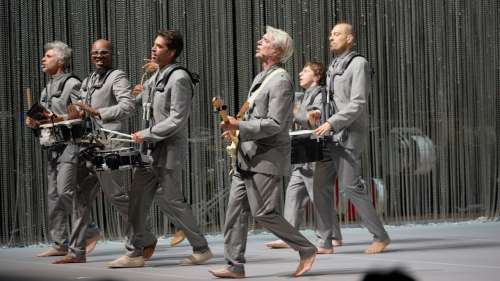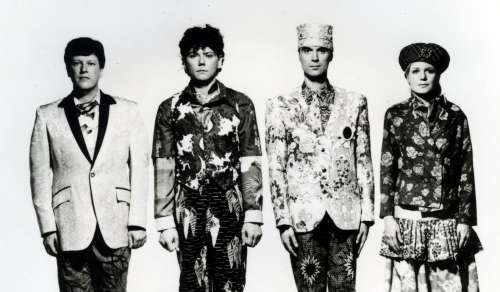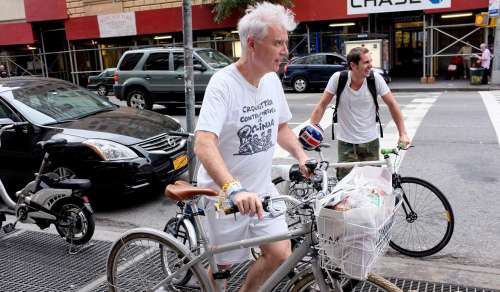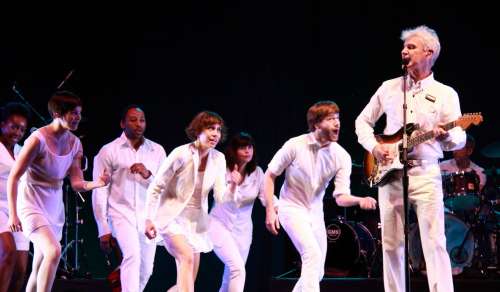Talking Head David Byrne on creating his American Utopia and pushing boundaries in a partisan world

Picture: Alamy
By Charley Lanyon
David Byrne is not tired. Maybe David Byrne is never tired. Months into his “American Utopia” tour, with months left to go (during which there will be a Hong Kong visit), Byrne, dressed in a pressed, white, tropical shirt with an iced tea in hand to ward off the central Texas heat, is fresh-faced and eager to talk when we meet in a conference room at the InterContinental Stephen F Austin Hotel, in Austin. A much younger man could be forgiven for wanting to sleep in, on this, a rare day off, especially after a show like the one he put on the previous evening.
Byrne treated nearly 3,000 people at Austin’s Bass Concert Hall to a spectacle of constant motion and precise choreography that was, in some ways, more akin to a ballet than a traditional rock ’n’ roll show – albeit a ballet in which the dancers had to perform while lugging around guitar, keyboard and full drum kit. But for this 66-year-old, rest is the furthest thing from his mind. He is eager to get this interview finished so he can visit some of Austin’s art galleries – before going for a long bike ride.
Byrne, who was born in Dumbarton, Scotland, and arrived in the United States as a young boy, was a founding member and lead singer of Talking Heads, among the most important and groundbreaking bands in popular music history (with hits including Psycho Killer, Burning Down the House and Road to Nowhere). Since the band split up, in 1991, Byrne has produced a rich body of solo work and collaborated with artists such as Brian Eno and St Vincent; he has written books about music and his other passion, cycling; he has founded “Reasons to Be Cheerful”, a project for which he aggregates increasingly scarce good news; and he has tried his hand at theatre, producing Broadway’s first “disco opera”, Here Lies Love, in collaboration with Norman Cook, aka Fatboy Slim.
Behind the scenes, Byrne and his team have pioneered new technologies and adapted existing ones in the production of performances that would have been impossible to stage even just a few years ago.
“I am aware that you can lose people if you do too much,” he says, laughing. “They just think you’re a show off.”

Picture: Alamy
And a show-off Byrne certainly is not – he is normally reticent to discuss Talking Heads, although, in promoting his new album, American Utopia, and its tour, he has been willing to invoke the past, describing his new work as his first solo music in 14 years (which is technically true) and comparing the show to the groundbreaking 1984 concert film Stop Making Sense.
That Talking Heads performance, a triumph of often-irreverent, minimalist choreography, is widely regarded as a work of genius. Stop Making Sense is discussed in the same breathless tones as Igor Stravinsky’s debut of The Rite of Spring, in Paris, in 1913, when the ballet sparked a brawl in the audience.
There is growing consensus that, with “American Utopia”, Byrne has done it again. And it is this show that he will bring to Hong Kong’s Clockenflap Music and Arts Festival, on November 10.
Lyrically, Byrne is more comfortable in his own skin than ever. He exalts in the lyricist’s ability to inhabit different points of view, taken to giddy extremes in songs sung from the perspective of a dog or a chicken: “Now the chicken imagines a heaven/ Full of roosters and plenty of corn/ And God is a very old rooster/ And eggs are like Jesus, his son.”
“We’re driven by biases and forces and emotions,” Byrne explains. “We’re not completely rational and we see only part of what’s out there, like looking through a tube, and we make decisions based on having a partial view of the world. It’s the idea of not only empathising with another person about their situation or life, but thinking about what it might be from an animal’s point of view. You can imagine what things might look like to a chicken or a dog. You can easily imagine how limited their point of view of the world is. Then I’m asking us to turn around and realise, ‘Well, ours is just as limited.’ Let’s not pretend that we know it all.”
Musically, the new album is a step away from the minimalism Byrne has embraced in recent collaborations; he is freshly willing to indulge and the result is exuberant.
“On some of the songs there’s an undercurrent: sometimes the words are saying one thing and the music is saying something else,” he says. “Sometimes the music is more optimistic and affirming and uplifting, but sometimes the words are a little bit darker. That to me is something music can do in a way that can be really difficult in other mediums. I think that’s why people feel so strongly about music; why it becomes such a big part of their lives. It might be something that they’ve heard ages ago, but it has such a positive effect, and I think that’s because it can do so many different things at the same time.”
While Byrne says he did not produce the album with the live show in mind, the two have become deeply entwined.
It’s tempting to avoid describing the performance in any great detail, as you really should go in with as few expectations as possible – the better to be blown away. And that temptation is all the greater because the performance is so difficult to describe, defined as it is by so many contradictory characteristics: it feels as spontaneous and ecstatic as a gospel service, and as rigorously staged as an opera; it is techy but emotional; loosey-goosey and piano-wire tight; sparse and theatrical; minimalist but chaotic; an all-business musical orgy with a futurist soul. See what I mean?
If some singer-songwriters are storytellers, others poets, then Byrne is an ideas man. And if you could condense his most recent work into one idea, it would be “unpredictable movement”.
The show is choreographed by long-time collaborator Annie-B Parson, the artistic director of New York-based Big Dance Theatre. Parson and Byrne have gone out of their way to emphasise the literal and figurative freedom each of the 12 members of the band enjoys. At times, the band move in unison, but there is always tension, because at any moment, any one of the members could spin off on their own path, in their own kinetic world.
“It’s about what if the entire band can all be mobile, so that means you can have a completely empty stage – and what does that mean?” Byrne says.
Anyone who has been following the artist’s career knows that his fascination with mobile performance is not new. He has long taken inspiration from drum lines and samba schools, and has been known to invite brass and marching bands on stage with him. “American Utopia” is his chance to take mobile music to its extreme. And realising Byrne’s dream of a “truly empty stage” in constant motion requires a large, complex, technologically advanced support system.
Each musician has to be lit individually and each instrument must be wireless but amplified so that it can be heard by arena-sized crowds wherever its player ventures on stage, whether they are running, jumping or turning their back on the audience.
One gets the sense that these are concepts Byrne has been toying with since the beginning of his career but only now, thanks to technological advancements in everything from lighting to microphones and amplifiers, is he able to realise his vision.
“Stop Making Sense was kind of pushing the technology at the time,” Byrne says. “Like this show, it emerged from a very simple idea. To realise those really simple ideas, there’s a lot of technology behind the scenes.”

Picture: Alamy
In “American Utopia”, spotlights track sensors sewn into the performers’ clothing and much of the lighting is provided by state-of-the-art LEDs.
“We’re not using traditional amplifiers for guitars or keyboards, they’re kind of amp simulators that all exist on a rack, which means there’s less shipping and there’s none of that loud noise, on stage or off,” says Byrne. “They’ve had them before but now they’re getting to the point where you can’t audibly hear the difference [in quality]. And when I heard about the lighting sensors, I thought, ‘For what I’m trying to do, this would really be perfect. This would really push that technology to the limit, to have it tracking 12 people.’ There are certain songs where I know I can run around and move however I want and the light will totally track me in a way that a follow-spot operator could never ever do.
“There are some songs where you would need 12 follow-spot operators to be doing this.”
There’s technology, though, and there’s technology. He is, says Byrne, “fairly apprehensive about technology and how it shapes our lives and our thinking, and how we relate to one another”.
“Technology is best when you choose it. You choose how to use it to fit your concept. You stay the master because technology will tend to guide you to do things that it does best. If it’s technology that helps me do what I want to do, that’s great, but I don’t want to just jump in because it’s there.
“Easier can be a real seduction.”
Byrne strives to keep his work above the fray, but like any artist working in today’s world, creation is inevitably a political act. He tries to strike a balance – the role of music and performance in his life is to bring people together, to make them aware of their humanity – but just as music can soothe, so it can educate and warn. Is an artist obliged to use his work to improve the world, expose injustice and lend a voice to the silenced?
At each show on the American leg of his tour, Byrne urges the audience to vote in the US midterm elections on November 6.
“I don’t know if it’s right or wrong or even the most effective [approach], but my feeling has been to respect the audience’s judgment and not tell them to vote for this candidate or do this or that, not tell them what to do,” says Byrne, “but to remind them that you have a choice and you are obliged to make that choice and act on it.”

Picture: Alamy
That gesture has received less attention in the press than his choice of final song. For the finale at every show, Byrne performs the set’s only cover song, Hell You Talmbout, the original of which is by actress and musician Janelle Monáe. The song is an impassioned remembrance of black victims of police violence in the US, a percussive chant of the names of those who have been murdered with angry pleas to “say their name”.
Byrne is aware of the potentially awkward optics of him, a white man, singing a song by a black woman about black suffering, but he asked Monáe for permission to perform it and was told that it was a song for everybody. In cities all over an increasingly divided US, the incongruity of the song, coming from Byrne’s mouth, and at the end of a show that is so defiantly otherworldly, only adds to its power.
“We’ve had walkouts on the last song,” he says. “Sometimes we can tell they’re walking out because they disagree and sometimes they might be walking out because they want to get to the parking lot before anybody else. That song, I feel, isn’t necessarily a partisan song. It doesn’t endorse a candidate or party, it’s about fixing a social wrong.”
Byrne may be careful to keep his music apolitical, but he is a political person, engaged with the world and global current events. That kind of engagement, in today’s climate, can be depressing, even debilitating. As an antidote to the barrage of bad news, Byrne started collecting examples of good news that had been ignored by mainstream media.
Eventually, his news collecting became “Reasons to Be Cheerful”, a stage show-cum-PowerPoint presentation of optimism he gave in New York in 2017. This year, Byrne unveiled the “Reasons to Be Cheerful” online platform, organised into categories such as “Civic Engagement”, “Culture” and “Climate and Energy”. On the website is an interactive world map with pins indicating places in which good things are happening.
Although there is apparently plenty to be cheerful about in Europe and North America, the only positive Asia has going for it on the map is the fact that “Cambodia is on track to achieve 0% open defecation and country-wide latrine coverage”. Here in Austin, the “Sadler Means Young Women’s Leadership Academy has been successful in building a Makerspace [a workshop in which students can create whatever takes their fancy] in their building”.
When he is not peddling fine tunes or good news, Byrne can often be found pedalling a bicycle. In New York, he is a common sight astride one of the machines belonging to Manhattan share programme Citi Bike. And on tour, a number of bicycles follow him together with his stage equipment.
“I go out on bike rides most days,” says Byrne. “It combines exercise with a kind of a psychological decompression, where I’m getting away from all the music stuff and all the tour stuff, and I’m just taking in wherever it is I am. It’s kind of an exercise in meditation.”

And Byrne is not content to just ride. He has written a book about cycling, Bicycle Diaries (2009), and designed an urban-parking bike rack, versions of which have been installed in New York and California’s Bay Area.
Byrne has recently found lots in Hong Kong to be cheerful about. In 2009, he was well-received when he stopped in the city, complete with bicycle, on his “Songs of David Byrne and Brian Eno” concert tour (it was “one heck of an eccentric concert on Monday night at the Hong Kong Convention and Exhibition Centre”, according to the South China Morning Post reviewer). And, he says, he has visited as a tourist many times. “I always enjoyed Hong Kong,” he says.
In 2013, however, some Hongkongers’ hackles were raised when Byrne used the city as a cautionary tale in an opinion piece he wrote for The Guardian newspaper about how skyrocketing rents were strangling culture in New York.
“I’ve been in Hong Kong,” wrote Byrne, “and unless one already has the means to live luxuriously, business hubs aren’t necessarily good places for living. Cities may have a mercantile exchange as one of their reasons for being, but once people are lured to a place for work, they need more than offices, gyms and strip clubs to really live.”

Picture: Alamy
Consequently, he sees Clockenflap as part of a cultural flowering in Hong Kong.
“I’m sensing that since the last time I was there, which wasn’t that long ago, there’s been a lot of change,” says Byrne. “There are art museums that have opened and art collections, and theatre productions, and there’s a lot more international music and a lot more cultural institutions. I feel like there’s been a realisation that all work and no play is maybe not the best thing.”
While Byrne is too modern to comfortably fit the category of a classic rocker, his status as an iconic musician has been more than 40 years in the making. Contemporaries have contented themselves with trotting out hits in classic rock reviews, taking up residencies in Las Vegas or retiring from the stage altogether, but Byrne continues to push boundaries. A bit.
“I do feel an obligation to perform some of the hits,” he says, laughing. “There’s enough of them. I know that if I only play the brand-new stuff […] I’m going to play to a smaller crowd. Then I can’t afford to do a show like the one I’m doing. And that’s fine if you accept that you can’t have your cake and eat it, too.”
On the other hand, he says, “I’m very much aware that I don’t want to become an oldies act, every couple of years going out and playing the hits. That would be creative death.”

As if to prove his creative vitality, Byrne mentions a theatre piece about “neurological experiments” that he has in the pipeline. He will not say much more about it other than to remind me he has form when it comes to theatre.
“Not to be immodest,” says Byrne, and you believe he means it, “I did this theatre show Here Lies Love [which premiered in 2013], this immersive disco show where the theatre is turned into a disco and it tells the story of [former Philippine first lady] Imelda Marcos and all the actors are doing karaoke […] Basically, I thought, ‘I want to revolutionise what a musical theatre show can be.’
“And then, with [‘American Utopia’], I thought, ‘I want to revolutionise what a pop concert can be,’” and here he catches himself, “again.”